LinkedIn or LinkedOut?

Dr. Christopher Leo
UCF Department of Integrated Business
Perhaps the greatest gift a faculty member can provide a student is an assignment that contributes to their success beyond their academics. Integrative-learning assignments have the potential to empower our students by enabling them to leverage their classroom experience for future endeavors, to develop the ability to accurately assess their own skills and knowledge, and to persuasively articulate their academic achievements for different professional audiences. While integrative-learning assignments might fall beyond the scope of most discipline-specific curricula, creating a successful integrative-learning assignment that fits into any major is not as hard as you may think. Any faculty member—from mathematics to music—can create an integrative-learning assignment that helps students see the relevance of their course work to their lives beyond the university.
I teach a course called Applied Business Technology, a course which focuses on using business-related technologies to solve problems for firms. As I was designing the course, I quickly discovered that many business “tech tools” can also be leveraged by students to better prepare themselves for life after graduation. This led to the Individual LinkedIn Assignment, in which students create their own, robust LinkedIn profiles to illustrate their value to potential employers.
The research is clear, LinkedIn users’ strong ties play a “significant role in job search and are especially helpful in generating job leads, interviews, and offers” (Garg and Telang, 2011). In a recent article published in the Journal of Management, researchers found that the internet and professional social networking websites (SNW) like LinkedIn are now being used as the primary recruiting pool by employers in a wide range of fields when trying to identify prospective job candidates (McCarthy, Bauer, Truxillo, Anderson, Costa, Ahmed, 2017). With over 500 million users, LinkedIn is an essential tool all of our students should be familiar with and, with a little help, all of our students can develop an “All Star” profile.
The LinkedIn Assignment
I start off by having every student create an initial LinkedIn profile without assistance. Should they already have a profile, they may use their current profile for this step of the assignment. They then submit their profiles into Canvas (this is Part 1 of the assignment) to serve as their current benchmark for success.
For Part 2 of the assignment, I provide students with the LinkedIn Assignment which walks them through several steps that will help them create a top notch, “All-Star,” LinkedIn profile. While some elements of the assignment can be completed quite quickly, I allow several weeks for them to complete Part 2 because part of the assignment requires that they solicit LinkedIn connections from teachers, supervisors, and peers and obtain skill endorsements to help establish their professional capabilities, culminating in obtaining a total of five written recommendations on the LinkedIn platform that discuss the student’s hard and soft skills. This requires students to get out of their comfort zone and create real networking connections: connections they may choose to leverage in the future for their professional and academic success. This also gives students both a network and experience for asking for future professional or academic recommendations when it comes time to apply for graduate school or seek employment in that first post-graduation job.
On the due date, students are asked to convert their new “All Star” LinkedIn profile into a .pdf and submit it in Canvas (completing Part 2 of the assignment). Grading the assignment is done through a simple checklist of the steps that I’ve asked them to complete:
- Step 1: A Professional Photo (no points)
- Step 2: Customize your Public Profile URL (5 points)
- Step 3: Complete the Summary Section of your Profile (5 points)
- Step 4: Add your Education details, current Employment position(s) & previous Work History (including Internships) (5 points)
- Step 5: Show Work Samples (5 points)
- Step 6: Add at least 10 skills to your profile and get endorsed for your skills (5 points)
- Step 7: Connect with at least 50 peers and professionals (5 points)
- Step 8: Solicit Five Written Recommendations (no points)
- Step 9: Add “Honors, Awards, Lynda.com Certifications” (no points)
- Step 10: Check your Network Updates (5 points)

I have my students submit their LinkedIn profile as a .pdf file to help facilitate grading; LinkedIn allows all its users to convert their current profiles into .pdf’s, making this easy to do for students regardless of technological literacy.
Check out the following practitioner articles that discuss the importance of having a LinkedIn presence:
Some of the graded sections are simply pass/fail (e.g. either they have a customized LinkedIn URL or they don’t) while other sections (Step 3) require more attention as it relates to grammar, punctuation, and other writing techniques. The sections that do not have points assigned are sections that we strongly encourage our students to pursue (Steps 1, 8, and 9) but have no fair means of holding them accountable towards completion.
The assignment is worth more to my students than just points in my course, however. Several years ago, a student approached me with a message that she received from a corporate recruiter who found her LinkedIn profile and was impressed. The recruiter encouraged her to apply for an open position and she subsequently was offered an interview by that firm:
Gina’s profile illustrates the difference between an “All Star” LinkedIn portfolio and what is commonly submitted by students as Part 1 of the assignment. Because a picture says a thousand words, compare and contrast the following:
Student A LinkedIn Profile
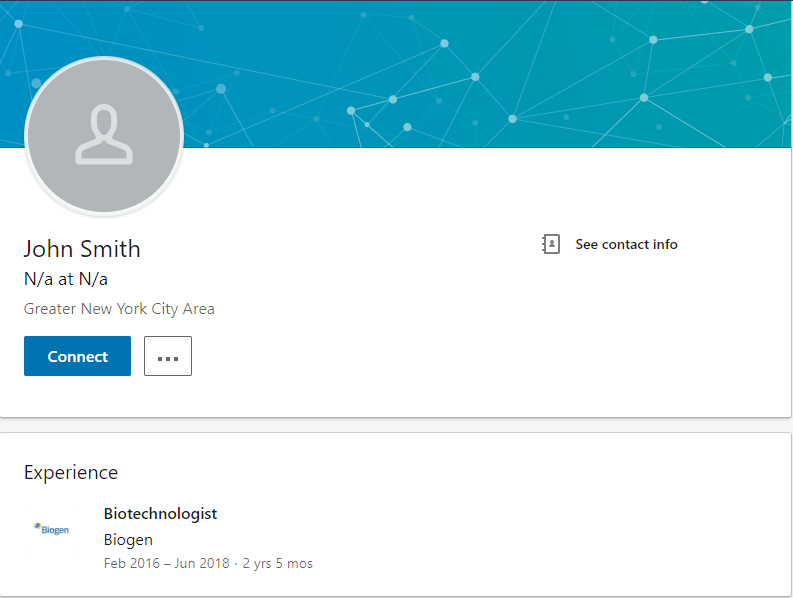
Gina's LinkedIn Profile
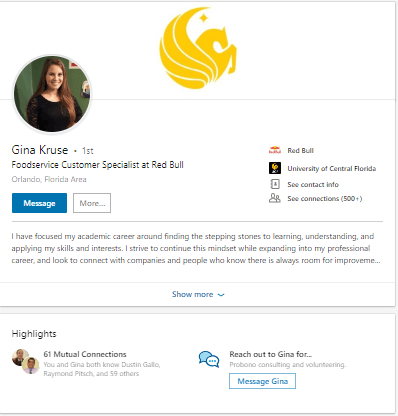
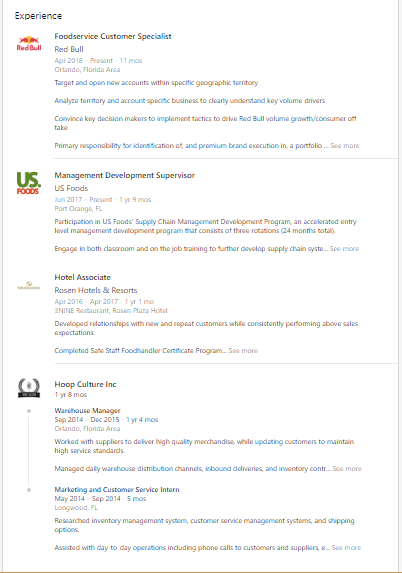
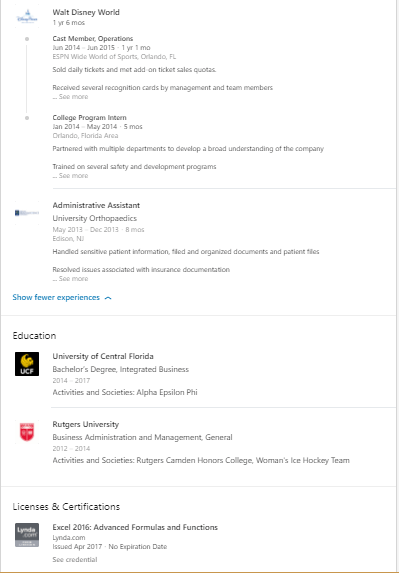
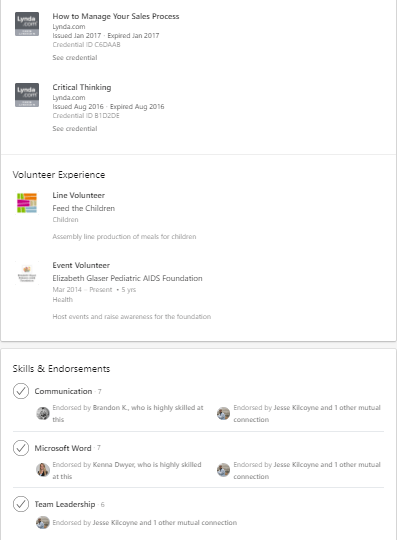
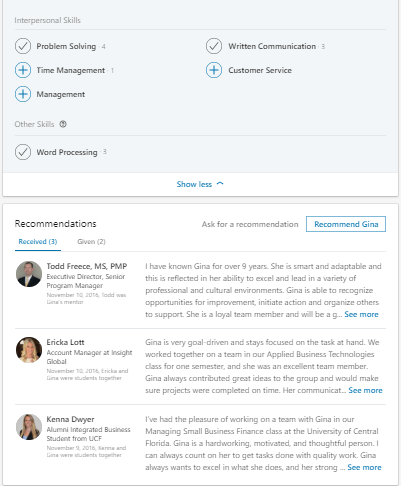
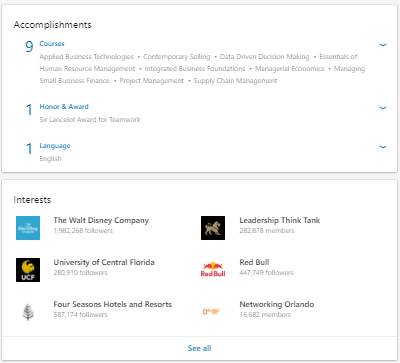
By completing the assignment, Gina was able not only to stand out in her academics within my class, but to develop a powerful tool she was able to leverage successfully for multiple jobs down the line.
If we encourage and direct our students to this professional (and free) platform so they can organize, synthesize, and display all of their accomplishments and endorsements, we even help open doors to them, perhaps even in fields outside their own, that they may not have discovered on their own. What’s great about this assignment is that it is 100% transferable for any student, in any academic program, as nearly every discipline uses LinkedIn for recruiting and networking. The assignment takes anywhere from 10-15 minutes to grade. When discussing this assignment in-class, I’ll allocate 30 minutes of in-class time to go over what an “All-Star” profile looks like and then answer any questions that students may have. Often times, I’ll pull up a model LinkedIn profile so they’ll have a benchmark to compare.
I encourage you to take a look at what incorporating LinkedIn into your curriculum can do to help your students succeed.
Find Out More:
Here are some academic articles that also discuss the benefits of having a LinkedIn profile:
- Garg, R., & Telang, R. (2011). To be or not to be linked on LinkedIn: Job search using online social networks. Available at SSRN 1813532.
- McCarthy, J. M., Bauer, T. N., Truxillo, D. M., Anderson, N. R., Costa, A. C., & Ahmed, S. M. (2017). Applicant Perspectives During Selection: A Review Addressing “So What?,”“What’s New?,” and “Where to Next?”. Journal of Management, 43(6), 1693-1725.